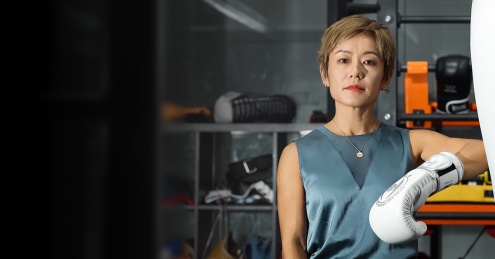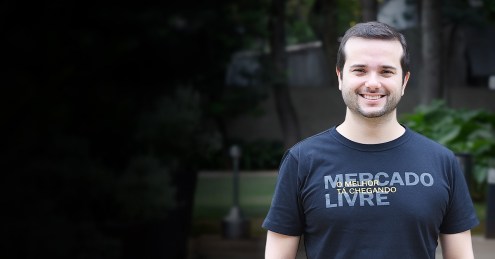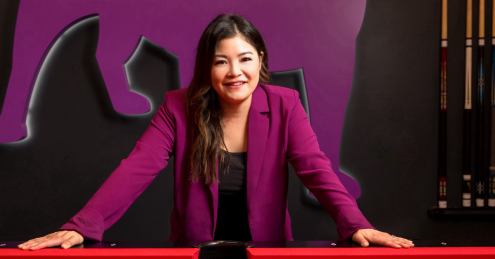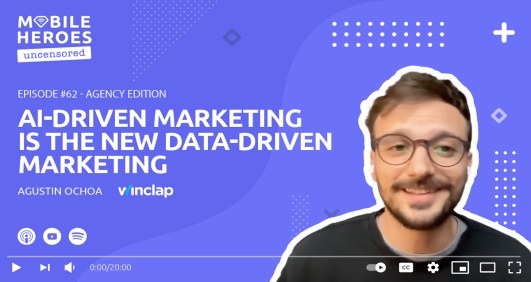Q&A with Agustin
Agustin Ochoa is Director of Paid Media at Winclap. His beginnings in digital marketing started at IMS Internet Media Services, where he worked on the programmatic team until 2017. Agustin later moved to Google to help the DoubleClick team – now known as Google Marketing Platform. From 2017 to 2022, Agustin worked in Google’s gTech, Sales and Tech. More recently, Agustin leads Media Buying at Winclap with a team of 30+ performance specialists.
Read Agustin's latest article: "How to Diversify Your User Acquisition Strategy to Scale a 7-Digit Budget"
In your own words, tell us about the Winclap business you manage?
I manage our Consultative Media Buying solution, where we combine media, creative and tech to help our clients scale on mobile.
We have a team of experts in performance campaigns for user acquisition strategies, re-engagement or branding. We leverage tech-enabled solutions to maximize growth while maintaining efficiency.
How did you get started in mobile marketing?
I worked with multiple clients with both web and app properties. As mobile grew and the industry changed, I worked on projects related to apps, omnichannel and 360 strategies.
At Google, I saw how large companies suffer from data fragmentation and an incomplete user view. Different CRM systems kept information, the data was incomplete, and data sources were all disconnected.
The mobile ecosystem also wasn’t developing in Latin America at the time. That's when I decided to dig deeper into mobile and work on solutions that facilitate growth.
If you could start in mobile marketing again, would you do anything differently? Why and what would you do?
The industry is so changeable that today it is easy to look back and say what things I would have focused on in the past. If I had to choose one, I would be more attentive to measurement topics–attribution and incrementality in particular.
What do you like most about mobile marketing?
What I like most is helping the companies that improve our lives through technology. Whether it’s democratizing finances, bringing mobility solutions, or facilitating the acquisition of products or services, I feel I contribute to something greater for society.
What do you see as the next big thing in mobile marketing?
Since AI-driven marketing is almost a reality, I think the next big thing is CTV performance campaigns.
TV consumption of content through the Internet is in full growth, and we have already seen how advertising is gaining ground with great segmentation capacity and more placements.
CTV is widely adopted for branding strategies but I believe we will see an increase in CTV user acquisition campaigns in the coming months. Probably with post-view attribution between devices connected to the same network, but surely with more innovation in the future.
In your opinion, what mobile strategies work best to meet performance and brand marketing KPIs?
Often, the most difficult part is setting KPIs. Sometimes advertisers are unsure what to look for, why targets have been set, or how it impacts a larger strategy.
In performance strategies, the focus is usually on efficiency metrics such as CPA or ROAS. But you must also look at growth metrics that analyze volume. As Nicolas Darveau-Garneau shared last year, we risk focusing on growing a bonsai rather than a sequoia if we overlook the growth metrics. Campaign success comes from the LTV / CAC ratio.
For branding, look at qualitative measurement, not only reach and frequency metrics. Qualitative measurements help us obtain more valuable insights.
In the past year, what is one tip you can share which made the biggest performance difference for your clients’ mobile strategy?
Today one of the main levers to improve performance is in the creatives. Giving creatives a seat at the table is essential to success. Test and find the best creative, data and media combinations.
Creatives are important, so the team creating and producing them must be connected with the rest of your team. In many cases, teams leave creatives at the end of the process and keep creatives separate from other efforts.
No matter how much effort you put into targeting, media optimizations, advanced audiences & technology, if you only recycle ads using a "one-size-fits-all" methodology, you’re missing out on great opportunities. You need to adapt your content to the channels, placement and overall context of the user. Staying relevant is key since much of the success of your campaigns depends on the message that the user receives.
What advice can you offer marketers to successfully re-engage mobile users?
I recommend focusing on first-party data and measurement.
We want to re-engage users, so it is important to understand who they are, how and when they found out about us, how they interacted with our brand, how often, why they stopped using, etc.
For this, having a strong first-party data strategy is key. Ensure data collection, close the gap between online and offline, understand customer journeys and unify & consolidate all data in a CDP—and of course, have the tools to activate this data.
At the same time, pay close attention to measurement to understand if the strategies are really incremental, or if they are cannibalizing other channels.
I have seen cases where retargeting campaigns work very well if you look at the metrics, but when we double clicked, we found that they were impacting users within UA cohorts with very low incrementality for the business.
What’s your top tip when it comes to mobile ad creative?
The first thing is to adapt your communications to each placement/channel and not to recycle ads. Each placement/channel differs in its best practices and ways of delivering a message.
In programmatic, it is a continuous process of designing, testing, learning and scaling. Often, the first creatives launched won’t perform the best. That is what you should expect. But as an advertiser, you must strive for continuous improvement to be successful. Do not make hasty decisions like pausing a campaign or a channel in the first weeks.
What advice can you offer to help marketers combat mobile ad fraud?
Ask for transparency regarding clicks, impressions and publishers from your media partners. If you see any suspicious pattern in the attribution data or missing information, check if there are valid reasons. It’s a given but pick transparent partners.
Secondly–look at incrementality testing. Fraudulent media is not incremental because it only attributes events generated by other channels. Measuring incrementality provides definitive information on whether a media partner generates real value.
Lastly, analyze organic traffic trends since fraudsters often attribute events driven originally by organic traffic.
What are your top 3 go-to resources for keeping up with the mobile ad tech industry?
- Friends and colleagues from the industry
- Emarketer
- Mobile Dev Memo























